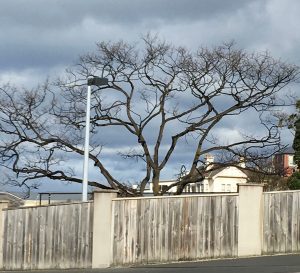Visualise if you will, a Lion’s tail; a smooth tapering tail with a tuft of fur at the end. When seen on a lion or a feather duster the silhouette is correct, it looks natural and is acceptable to the eye. But when seen on a tree, it looks un-natural, wrong even – and that’s because it is. ‘Lion’s tailing’ is a name given to a particular type of poor pruning and lazy practice. Lion’s tailing’ involves removing all of the internal small braches from a main branch and leaving only the ones at the very end. The resulting branch resembles a Lion’s tail or anything else that is long and skinny with a tuft at one end… a toilet brush.

When applied to the entire tree, the succession of lion’s tails creates a tree with a shell of foliage – the shell wall being the tuft. To achieve this the form of pruning (and in this example I will have to call it pruning as each cut was a correct pruning cut) the arborist (and it most likely was an arborist) just cut off everything they could reach. They effectively climbed into the tree and gutted it.
The effects on the tree are long reaching, complicated and potentially disastrous. The loss of leaf area (photosynthetic surface) means the tree will have reduced capacity to generate food (a shocking word, but it’ll do for now). With the removal of all of the small internal branches the main branches will bend and sway excessively – small internal branches act to soak up the energy in movement and help keep the limb in position – the purpose of a branch is to position the photosynthetic surface to maximum effect.
In the short term, as a result of the loss of leaf area (the reduced food making capacity) the tree will be slow to close over the pruning cuts but even slower to put down reaction wood (to grow its own reinforcing). The poor tree is then faced with a dilemma; does it invest in growing more leaves which will increase end weight and increase potential movement, or does it invest in growing reaction wood to try and support the few leaves it has? Either way the tree is forced into responding (trees don’t think – they respond), but with the reduced leaf area it is going to be limited it what it is able to do.
The mid-term effects are several and made even more complicated due to the urban location of the tree. With such a thin shell of leaves there is nowhere for the tree to naturally retreat to during extremes of hot or cold – trees can ‘sacrifice’ their outer canopy and rely on their inner canopy during times of stress. Without any internal branches future management becomes limited – how can you reduce a main branch back to a lateral branch if all of the lateral branches have been removed? When you are in the tree working, where do you stand when lateral branches have been removed? With the main branches excessively bending, branch failure is a real possibility – branch failure in the urban environment is never desirable.
The long term effects are almost irrelevant given the damage and done but if the tree was ever able to get to a right old age it could possibly retrench itself (downsize if you like). It could invest its energy into smaller closer growing limbs and let the outer branches go – retrenching could considerably extend its useful life… but for that to happen, it would have to have smaller closer growing limbs to retrench too.
This poor pruning and lazy practice has indeed harmed this tree and the effects will continue for many years to come – the saddest thing is that correct pruning, would have been easier to do, it would have been quicker and therefore presumably cheaper for the client. So not only has the client paid to have their tree maimed but the arborist has had to work harder than they needed to, to achieve it.
0 Comments